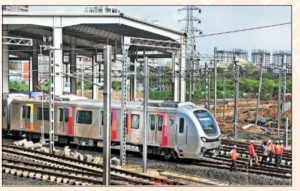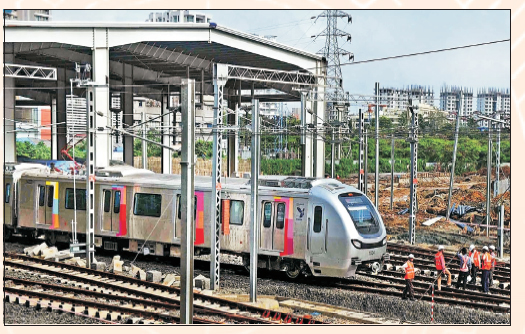Driverless Metro
The inaugural trial run of India’s first metro train to be equipped for Unattended Train Operation (UTO) was flagged off by India’s urban development minister Mr M Venkaiah Naidu and the chief minister of Delhi Mr Arvind Kejriwal in a ceremony at Delhi Metro Rail Corporation’s Mukundpur depot on May 17 2016.
Though the concept of driverless train is not new in the developed countries, it is still a novel idea in India. In this context, the announcement of Delhi Metro’s first driverless train was a proud moment for India. On 4 June 2015, the first driverless trains arrived in Delhi. These trains will ply on the Phase III corridors covering 58-km long Majlish Park-Shiv Vihar (Line 7) and the over 38-km long Janakpuri (West)- Botanical Garden (Line 8). The trains will be fully operational by the end of 2016.
Driverless trains have the advantage of not committing human error. Automated metro trains are more energy-efficient and always run on schedule. It is said that energy consumption by these trains can be cut by 30% depending on the degree of automation. Moreover, these trains will be able to carry 50 passengers more in each coach as compared to the driver-driven metro trains. Considering the driverless metro networks in advanced cities of the world whose safety records are generally excellent, we should not worry much about the safety of driverless trains in Delhi.
Some of the advanced features in these driverless trains are:
- These trains are significantly upgraded and eco-friendly.
- These trains can run at a maximum speed of 95 kmph and their operational speed is 85 kmph.
- CCTV cameras are installed for inside and outside view of the train. The CCTV images could be directly accessed by the control centre in driverless mode.
- Dynamic route maps are available in each door panel to let passenger know their journey status.
- While the present metro coaches already have 230V AC charging sockets, the new generation metro trains will have USB slots for mobile charging.
- The capacity of carrying passengers has also been increased in the new trains. Each coach can accommodate a maximum of 380 passengers, which means in the 6-coach train, almost 2,280 passengers can travel.
- The new trains are more energy efficient than the earlier ones with better regeneration of energy during braking.
- There are more energy-efficient subsystems inside the coach such as LED lighting and air conditioning systems.
- Each coach has four 18.5-inch LCD screens continuously displaying audio-visual messages and commercials.
- Fibre reinforced plastic seats have been introduced to add colour.
Types of Train Automation
 In metro systems, automation refers to the process by which responsibility for operation management of the trains is transferred from the driver to the train control system.
In metro systems, automation refers to the process by which responsibility for operation management of the trains is transferred from the driver to the train control system.
There are various degrees of automation (or Grades of Automation, GoA); these are defined according to which basic functions of train operation are the responsibilities of staff, and which are the responsibilities of the system itself.
According to the International Association of Public Transport (UITP), there are five Grades of Automation (GoA) of trains:
- GoA 0 is on-sight train operation, similar to a tram running in street traffic.
- GoA 1 is manual train operation where a train driver controls starting and stopping, operation of doors and handling of emergencies or sudden diversions.
- GoA 2 is semi-automatic train operation (STO) where starting and stopping is automated, but a driver operates the doors, drives the train if needed and handles emergencies. Many ATO systems are GoA 2.
- GoA 3 is driverless train operation (DTO) where starting and stopping are automated but a train attendant operates the doors and drives the train in case of emergencies.
- GoA 4 is unattended train operation (UTO) where starting and stopping, operation of doors and handling of emergencies are fully automated without any on-train staff.
What Makes Automation Possible?
Technical progress has made train control systems capable of supervising, operating and controlling the entire operational process. The key elements for this are:
- Automatic Train Protection (ATP) is the system and all equipment responsible for basic safety; it avoids collisions, red signal overrunning and exceeding speed limits by applying brakes automatically. A line equipped with ATP corresponds (at least) to a GoA1.
- Automatic Train Operation (ATO) insures partial or complete automatic train piloting and driverless functionalities. The ATO system performs all the functions of the driver, except for door closing. The driver only needs to close the doors, and if the way is clear, the train will automatically proceed to the next station. This corresponds to a GoA2. Many newer systems are completely computer controlled; most systems still elect to maintain a driver, or a train attendant of some kind, to mitigate risks associated with failures or emergencies. This corresponds to a GoA3.
- Automatic Train Control (ATC) performs automatically normal signaler operations such as route setting and train regulation. The ATO and the ATC systems work together to maintain a train within a defined tolerance of its timetable. The combined system will marginally adjust operating parameters such as the ratio of power to coast when moving and station dwell time, in order to bring the train back to the timetable slot defined for it. There is no driver, and no staff assigned to accompany the train, corresponding to a GoA4.
Driverless Train Operation
The next step from semi-automatic train operation, which automates some aspects of train operation but still requires a driver to be in the cab, is driverless train operation. This technology, in operation on the likes of London’s DLR, involves the automatic handling of all aspects of train operation, with a trained human operator on board the train to handle customer service, ticket checking and to take control in the event of an emergency.
But increasingly, modern networks like the Dubai Metro, Tokyo’s Yurikamome and elements of the metro networks in Paris and Barcelona are embracing true driverless systems, with trains run automatically with no onboard staff necessary. All operations are overseen by a vast array of remote technologies, from CCTV and onboard telemetry to automatic detection systems. These advanced lines are monitored by a control centre that tracks all trains and potential hazards.
As the technology continues to mature, it has spread beyond the developed world, with cities like Delhi and Shanghai in various stages of driverless development for their metro systems. In March this year, the Delhi Metro Rail Corp received a bid from Thales to implement its SelTrac communication-based control system. A remotely controlled, automatic system is being heavily indicated for inclusion as part of the Delhi Metro’s next phase of expansion.
Why choose metro automation?
Unattended Train Operation has many benefits and many beneficiaries: customers, operators, funding authorities and staff.
The implementation of UTO systems allow operators to optimize the running time of trains, increasing the average speed of the system, shortening headways up to 75 seconds, and reducing dwell time in stations (in optimal conditions) to 15 seconds.
Greater Flexibility in Operation
By taking the human factor out of the driving equation, operators gain flexibility and can make better use of assets. UTO systems offer a more tailored service coverage, reducing overcapacity supply at off-peak hours and enabling operators to inject trains in response to sudden surges in demand, for example in the case of big events.
Impressive Safety Records
UTO systems also offer safer operations by reducing the human-risk factor; well designed UTO systems have proven to be more reliable than conventional metros and hold an impressive safety record. Platform and track incidents aside, there has been only one operational incident in Osaka, at the end of the 80s, when a train did not stop at terminus and hit a bumper stop, provoking injuries in a few dozen passengers.
Increase in Quality of Service
Overall, passengers perceive an increased quality of service, thanks to the enhanced reliability of trains and shorter waiting times in platforms. The re-deployment of staff in stations also increases passenger’s level of subjective safety and security.
Author :
- Anita Sharma – anitasharma.sharma@gmail.com

